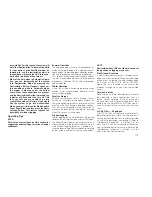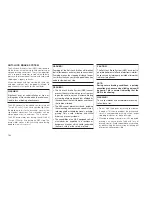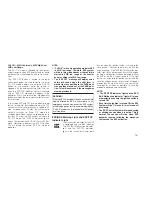
•
Check threaded fasteners for looseness, par-
ticularly on the chassis, drivetrain components,
steering, and suspension. Retighten them, if
required, and torque to the values specified in
the Service Manual.
•
Check for accumulations of plants or brush.
These things could be a fire hazard. They might
hide damage to fuel lines, brake hoses, axle
pinion seals, and propeller shafts.
•
After extended operation in mud, sand, water,
or similar dirty conditions, have brake rotors,
wheels, brake linings, and axle yokes in-
spected and cleaned as soon as possible.
WARNING!
Abrasive material in any part of the brakes may
cause excessive wear or unpredictable braking.
You might not have full braking power when you
need it to prevent an accident. If you have been
operating your vehicle in dirty conditions, get
your brakes checked and cleaned as necessary.
•
If you experience unusual vibration after driving
in mud, slush, or similar conditions, check the
wheels for impacted material. Impacted mate-
rial can cause a wheel imbalance and freeing
the wheels of it will correct the situation.
PARKING BRAKE
To set the parking brake, pull the lever up as firmly
as possible. When the parking brake is applied
with the ignition ON, the “Brake Warning Light” in
the instrument cluster will light. To release the
parking brake, pull up slightly, press the center
button, then lower the lever completely.
NOTE:
The instrument cluster “Brake Warning Light”
indicates only that the parking brake is ap-
plied. You must be sure the parking brake is
fully applied before leaving the vehicle.
Be sure the parking brake is firmly set when
parked, and the shift lever is in the PARK position.
When parking on a hill, you should apply the
parking brake before placing the shift lever in
PARK. Otherwise, the load on the transmission
locking mechanism may make it difficult to move
the shift lever out of PARK.
WARNING!
•
Always apply the parking brake fully when
leaving your vehicle or it may roll and cause
damage or injury. Also, be certain to leave an
automatic transmission in PARK or a manual
transmission in REVERSE or 1st gear. Failure
to do so may allow the vehicle to roll and
cause damage or injury.
•
Leaving unattended children in a vehicle is
dangerous for a number of reasons. A child or
others could be injured. Don’t leave the keys
in the ignition. A child could operate power
windows, other controls, or move the vehicle.
•
Be sure the parking brake is fully disengaged
before driving, failure to do so can lead to
brake problems due to excessive heating of
the rear brakes.
When parking on a hill, turn the front wheels
toward the curb on a downhill grade and away
from the curb on an uphill grade.
The parking brake should always be applied
whenever the driver is not in the vehicle.
Parking Brake
133
Summary of Contents for Cherokee 2009
Page 1: ......
Page 2: ......
Page 3: ......
Page 5: ...2...
Page 9: ...6...
Page 11: ...8...
Page 15: ......
Page 45: ...42...
Page 50: ...Rear Window Defroster If Equipped 89 ROOF LUGGAGE RACK IF EQUIPPED 90 47...
Page 51: ......
Page 63: ...60...
Page 64: ...61...
Page 65: ...62...
Page 97: ...INSTRUMENT CLUSTER 94...
Page 106: ...Compass Variance Map 103...
Page 111: ...Compass Variance Map 108...
Page 116: ......
Page 120: ...117...
Page 123: ...Control Setting Suggestions for Various Weather Conditions 120...
Page 147: ......
Page 159: ......
Page 162: ......
Page 175: ...172...
Page 179: ......
Page 210: ...9 IF YOU NEED CONSUMER ASSISTANCE IF YOU NEED ASSISTANCE 208 207...
Page 212: ...209...
Page 213: ...210...
Page 214: ...10 INDEX 211...
















































